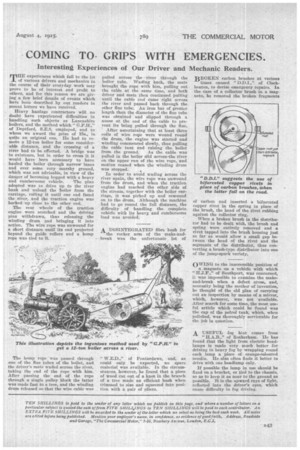COMING TO GRIPS WITH EMERGENCIES.
Page 27

If you've noticed an error in this article please click here to report it so we can fix it.
Interesting Experiences of Our Driver and Mechanic Readers.
T'
experiences which fall to the lot
of various drivers and mechanics in the course of their everyday work may prove to be of interest and profit to others, and for this reason we are giving a few brief details of events which have been described by our readers in recent letters we have received. Heavy haulage contractors will no doubt have experienced difficulties in handling such objects as Lancashire boilers, and the method which " of Deptford, S.E.8, employed, and to whom we award the prize of 15s., isquite an original one. He had to remove a 12-ton boiler for some considerable distance, and the crossing of a river had to be effected. A bridge was in existence, but in order to cross it it would have been necessary to have hauled the boiler through narrow lanes and over some very marshy ground, which was not advisable, in view of the danger of becoming bogged with a heavy and cumbersome vehicle. The plan adopted was to drive up to the river bank and unload the boiler from the carriage, rolling it until one end faced the river, and the traction engine was backed up close to the other end. The rear wheels of the traction engine were scotched and the driving pins withdrawn, thus releasing the winding drum and bringing it into action. The wire rope was unwound for a short distance until its end projected beyond the guide rollers and a hemp rope was tied to it.
The hemp rope was passed through one of the flue tubes of the boiler, and the driver's mate waded across the river, taking the end of the rope with him. After passing the end of the rope through a single pulley block the latter was made fast to a tree, and the winding drum released so that the wire cable was pulled across the -river through the boiler tube. Wading back, the mate brought the rope with him, pulling out the cable at the same time, and both driver and mate then continued pulling until the cable end came right across the river and passed back through the other flue tube. An iron bar of greater length that the diameter of the flue tube was obtained end slipped through a noose at the end of the cable to prevent its being pulled through the due. After ascertaining that at least three coils of wire rope were wound round the drum, the engine was started and winding commenced slowly, thus pulling the cable taut and raising the. boiler from the ground. As the cable was pulled in the boiler slid across-the river on the upper run of the wire rope, and motion ceased when the winding drum
was stopped. •
In order to avoid wading across the river again, the wire rope was unwound from the drum, and when the traction engine had reached the other side of the stream, together with the boiler carriage, it was picked up and rewound on to the drum. Although the machine had to go round the full distance, the difficulty of handling the complete vehicle with its heavy and cumbersome load was avoided.
A DISINTEGRATED fibre busk for the rocker arm of the make-d-break was the unfortunate lot of
of Pontardawe, and, as could only be expected, no spare material was available. In the circumstances, however, he found that a piece
cu a t out of of Wood knot in the branch made an
of a tree efficient bush when trimmed to size and squeezed into position with a pair of pliers.
BROKEN carbon brushes at various times caused " D.D.I.," of Cleckbeaten, to devise emergency repairs. In the ease of a collector brush in a magneto, he removed the broken fragments of carbon and inserted a bifurcated copper rivet in the spring in place of the brush, the head of the rivet rubbing against the collector ring. When a broken brush in the distributor had to be dealt with, the brush and spring were entirely removed and a rivet tapped into the brush housing just so far as would allow a small gap between the head of the rivet and the segments of the distributor, thus converting a brush-type distributor into one of the jump-spark variety.
OWING to the inaccessible position of
a magneto on a vehicle with which " H.3-.F.," of Southport, was concerned, it was impossible to examine the makeand-break when a defect arose, and, necessity being the mother of invention, he thought of the old plan of carrying out an inspection by means of a mirror, which, however, was not available. After search for some time, the most useful article which could be found was the cap of the petrol tank, which, when polished, was thoroughly serviceable for the job in question.
A USEFULfog hint comes from B.," of Rother "H.A.ham. He has found that the light from electric headlamps is made very much better for driving in he each lamp a heavy fog by wrapping round piece of orange-coloured muslin. He also often finds it better to drive with one headlamp only. • should If possible the lamp in use be fixed on a bracket, or tied to the chassis, so as to keep it as near to the ground as possible. It is the upward rays of light, reflected into the driver's eyes, which cause difficulty in fog driving.




























